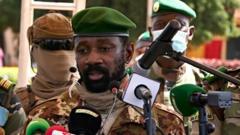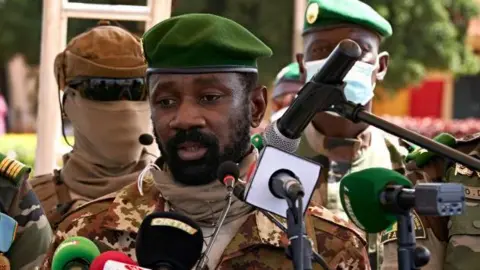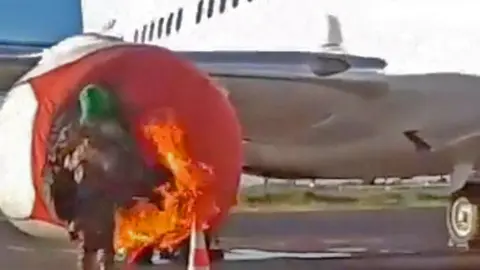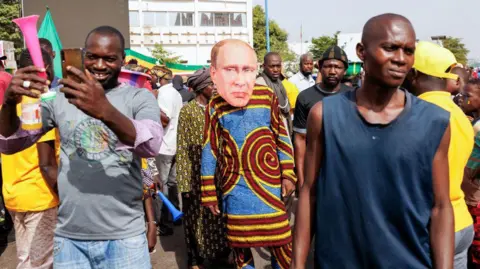This website uses cookies so that we can provide you with the best user experience possible. Cookie information is stored in your browser and performs functions such as recognising you when you return to our website and helping our team to understand which sections of the website you find most interesting and useful.

 Getty Images
Getty ImagesThe al-Qaeda flag flutters from an airport building. A jihadist places a burning rag in the engine of the presidential jet, others explore the VIP terminal or fire shots as they approach planes belonging to the UN Humanitarian Air Service (UNHAS) – a familiar survival lifeline for so many countries in crisis around the world.
The social media images broadcast by the jihadists who on Tuesday morning attacked the international airport complex outside Mali's capital, Bamako, and then roamed around the site, graphically demonstrate the fragile security of what should have been one of the most protected locations in the West African country.
A training centre for the gendarmerie (paramilitary police) in the Faladié suburb was also targeted. Residents filmed smoke rising above the skyline as explosions and gunshots shattered the dawn calm.
Just as shocking is another militant video - of fighters, their soft teenage faces a stark contrast with their weapons and combat uniforms - preparing themselves before launching the assault.
Mali's military rulers have not said how many people died, except that some trainee gendarmes had lost their lives, but it seems that at least 60 and perhaps as many as 80 or even 100 people were killed, with a further 200 or more wounded.
Those figures may or may not include the militants killed as government forces recovered control of the airport at Senou and the Faladié barracks.
 Reuters
ReutersOf course, these are far from the first images of conflict in Mali.
The country has been deep in crisis since at least late 2011, when northern ethnic Tuareg separatists and radical Islamist factions allied to them, took over Timbuktu, Gao and other towns across the north.
Bamako has suffered attacks before. In 2015 an assault on the upmarket Radisson Blu hotel claimed 20 lives and five more died in a shooting at a restaurant in the buzzy Hippodrome district.
In 2017, an attack on a tourism complex on the outskirts of the city killed at least four people.
In 2020 Col Assimi Goïta, an experienced combat commander, staged a coup criticising the elected government’s failure to effectively tackle the security crisis.
A civilian-led transition was soon established, but in May 2021 Col Goïta staged a second coup, to put himself and fellow officers firmly back in control.
But despite a reinforced focus on security, and the hiring of Russian mercenary outfit Wagner to provide extra military support - provoking a row with France that led eventually to the withdrawal of the several thousand strong French anti-terror force Barkhane - the new regime proved no more effective than its civilian predecessor in ending the violence.
Open conflict was mainly confined to the desert in the north and the more fertile central regions, where tensions were fuelled by competition between farming villagers from the Dogon ethnic group and livestock herders from the Peul (Fulani) community over precious land and water resources.
But there were occasional reminders of the jihadists’ capacity to range further south in this vast country, to Bamako and its environs.
In July 2022 militants staged two small attacks near the city and then attempted a big raid - trying to ram their way into the Kati barracks complex, the junta’s base just 15km (9.3 miles) north of the capital.
This showed the insurgents' ability to stage high-profile raids far beyond the more northerly regions, where their presence is an influential fact of everyday life.
However, the army managed to contain this assault, reporting two dead militants as the only casualties. And ultimately the Goïta regime was able to shrug off any wider impact from the incident.
Although the attack was attributed to Jamaat Nusrat al-Islam wal-Muslimin (JNIM), the al-Qaeda affiliated coalition of armed groups that is Mali’s largest jihadist force, it did not substantially weaken the junta’s self-confidence and capacity to set the domestic political and diplomatic agenda.
Just weeks later, the French completed the withdrawal of their troops, having been driven out by the regime’s political hostility and the ever-tightening rules through which it stifled the operational capacity of the Barkhane force.
And the next year the junta felt sufficiently emboldened to demand the winding up of the United Nations 14,000-strong peacekeeping force, known by the acronym Minusma.
 Getty Images
Getty ImagesSo will Col Goïta’s junta be able to brush off the highly publicised attacks of this week with the same self-confident control of the agenda that it managed after the July 2022 incidents?
Just as then, in a huge country whose territory could never be absolutely controlled by the official security forces, even backed up by Wagner - now renamed Corps Africa - it is not really surprising that a number of jihadist fighters managed to stage raids on locations on the outskirts of Bamako.
And such attention-grabbing forays still fall well short of the militant control over the large tracts of countryside and numerous villages that characterise parts of central and northern Mali.
However, the security picture in West Africa today is much more fragile than it was in 2022.
Across the central Sahel, JNIM and the other main jihadist faction, Islamic State in the Greater Sahara (ISGS), have been probing ever further south.
The military regime in neighbouring Burkina Faso - allied with the Malian and Nigérien juntas in the Alliance of Sahelian States (AES) - has lost control of large tracts of terrain, and quite possibly even the majority of rural areas.
And in Niger jihadists stage regular attacks all over the west, and even within an hour of the capital, Niamey.
Moreover, the militants now routinely range into the northern areas of coastal countries, particularly Benin and Togo. In Ivory Coast they have only been pushed back through a sustained military effort, backed up with a “hearts and minds” programme of development spending.
So the overall regional security picture is as difficult as it has ever been.
But in Mali itself, the mood has felt rather different.
Government forces last year mounted a highly successful campaign to seize back northern towns previously controlled by the Tuareg former separatist movement that had signed a peace agreement with the civilian government back in 2015, but which the junta has cancelled.
Although those northern groups inflicted a costly defeat on the army and its Russian allies at Tinzaouaten, in the Sahara Desert, in late July, the regime’s hold on the north’s key urban centres seems well established for now.
This campaign against the former separatists, and the army’s reoccupation of their Saharan headquarters, Kidal, has proved highly popular among southern public opinion on the streets of Bamako.
And Col Goïta and his fellow junta leaders have so far felt no need to make concessions to the West African bloc, Ecowas, as it proffers goodwill in the hope of persuading them to abandon their declaration of withdrawal from the community.
It seems unlikely that this week’s shocking attacks on the outskirts of Bamako will alter this dynamic, despite the humiliation of seeing JNIM fighters wander freely around the international airport site, where flights have now resumed.
Instead, there is a risk that, in the short term at least, the Malian regime will oversee a reassertion of nationalistic feelings - and with that, the risk of a deepening of inter-ethnic distrust, with the fingers of populist accusation all too often pointing at those groups regularly accused of jihadist sympathy or activism.
Among the flurry of social media videos to emerge from Bamako this week have been scenes not only of arrests by the authorities, but also what appear to be images of citizens’ “detention” of presumed suspects, and at least one lynching, with a man burned alive in the street.
So, as so often, it is members of the Peul community who find themselves the prime targets for such brutal reprisal in a nation desperately in need of peace and stability.
Paul Melly is a consulting fellow with the Africa Programme at Chatham House in London.
More BBC stories from Mali:
 Getty Images / BBC
Getty Images / BBC


 Africana55 Radio
Africana55 Radio 

